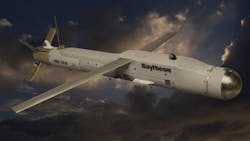EGLIN AIR FORCE BASE, Fla. – Smart munitions designers at Raytheon Technologies Corp. are preparing to test planned improvements to the U.S. GBU-53/B Small Diameter Bomb (SDB) II under terms of a $79.4 million contract announced Friday.
Officials of the Air Force Life Cycle Management Center at Eglin Air Force Base, Fla., are asking the Raytheon Missiles & Defense segment in Tucson, Ariz., to prepare for production cut-in fielding of several improvements to the SDB II.
These improvements include National Security Agency (NSA) cryptographic modernization; Global Positioning System (GPS) military code compliance; and parts obsolescence mitigation. As part of this contract, Raytheon also will deliver SDB II all-up round test vehicles, assemblies, checkout, testing, and systems integration.
The SDB II smart munition, also known as StormBreaker, can hit moving targets in bad weather. The winged munition autonomously detects and classifies moving targets in darkness, rain, fog, smoke or dust.
Like the GPS-guided GBU-39 SDB I already integrated on the F-35 joint strike fighter, the 208-pound StormBreaker with upgrades is six to seven inches in diameter. This size can fit eight StormBreaker munitions in the F-35’s confined internal weapon bays. If stealth is not a factor, about 16 more can fit on the F-35's wings.
The smart munition for guidance uses millimeter wave active radar homing, semi-active laser guidance, infrared homing with an uncooled imaging infrared camera, GPS-coupled inertial guidance, and radio data-links back to the aircraft.
Its millimeter wave radar detects and tracks targets through weather; imaging infrared provides enhanced target discrimination; and its semi-active laser enables the weapon to track a laser designator on the aircraft, or on the ground.
The tri-mode seekers share targeting information among all three modes to engage fixed or moving targets any time, and in any weather. The weapon can also fly more than 45 miles to strike mobile targets.
The StormBreaker can launch from the F-35, as well as from the Navy the F/A-18E/F Super Hornet carrier-based jet fighter-bomber. It also is officially approved for operational use on the Air Force F-15E jet fighter-bomber.
On this order Raytheon will do the work in Tucson, Ariz., and should be finished by April 2023. For more information contact Raytheon Missiles & Defense online at www.rtx.com, or the Air Force Life Cycle Management Center at www.aflcmc.af.mil.



